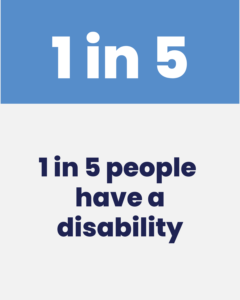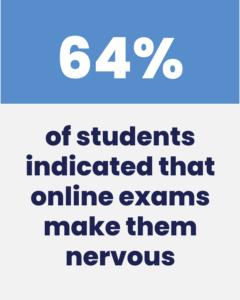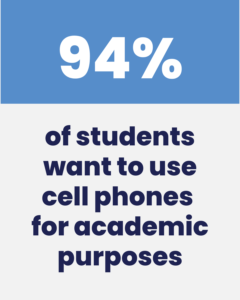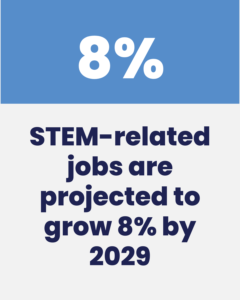22 online learning trends and changes to expect in 2022
1. Using Metaverse for a realistic online learning environment
What is Metaverse?
To summarize it, Metaverse provides a realistic virtual “world” that blends things like virtual reality, social media, gaming, collaboration technologies, and even e-commerce. Metaverse creates an immersive experience with lifelike avatars and ultra-realistic virtual environments that you can fully interact with by seeing and meeting people, touching objects around you in real-time, buying and selling products, and more.
Why Metaverse may be used in 2022
- Makes online classrooms feel extremely real
Instructors can build literal classrooms that students can enter, sit at a desk, raise their hand, and speak to others.
- Improves communication and engagement
- Students and faculty can collaborate in many ways in and outside of class
- Students can create study groups to connect and collaborate
- Faculty can hold department meetings and office hours
2. Increasing awareness and use of Open Educational Resources (OER)
What is OER?
OER refers to digital teaching and learning materials that are accessible to everyone and almost always free to use. OER materials come in various formats such as digital online textbooks, audio/video, gamification, and more.
Instructors and students can find a variety of materials from sites such as OER Commons, where they can filter based on the resource type, subject, education level, standard, and language.
How does Metaverse work?
- Makes it easier to customize online course content
Instead of being tied to a single textbook that students have to purchase, instructors can easily find OER resources and then pick and choose different resources to use in their course.
- OER materials are free or low cost for students
Did you know that a 2021 survey found that 65% of students chose to not purchase a textbook due to the cost? With textbook prices continually increasing, OER materials are a cost savings game-changer for many students.
3. Focusing on improving web accessibility in online courses
About 1 in 5 students have reported a disability. And with the wealth of web accessibility software and tools, assistive devices, and information available there’s no excuse to not create accessible online courses. It’s a foundational piece of improving online learning and creating an inclusive learning environment for every student.
Why focusing on web accessibility in online courses may increase in 2022
- Web accessibility can help increase student retention
While it varies from state to state and institution type, there are usually web accessibility standards that higher education institutions are required to.

4. Implementing strategies to help reduce student test anxiety
Testing can be inherently stressful for many students – especially in an online learning environment. In a 2020 survey, 64% of students responded that online exams make them nervous. The survey found that technology concerns and not knowing what to expect about certain aspects of the exam were the main causes of test anxiety.
Why strategies to reduce student test anxiety may increase in 2022
- Simple strategies can make a big difference
Simple strategies such as offering a practice exam and letting students know what to expect can help alleviate test anxiety.
- Some software can help decrease student test anxiety
The 2020 student survey showed that online proctoring services that blend AI and trained human proctors helped reduce student test anxiety.

5. Using online proctoring services
While some expected the use of online proctoring to be a quick-fix band-aid during the rapid shift to online learning due to covid, it’s continuing to be used – even as more institutions are transitioning to in-person classes.
Why institutions using online proctoring will continue in 2022
- Lets instructors use class time to teach instead of test
If you’re an instructor, think about how much of your class time is spent administering exams. With some online proctoring services, you get that time back because students can take exams outside of class and still get support if they have any issues.
- Creates a fair testing environment
With features such as detecting cell phones, locking down the browser, and video monitoring, online proctoring creates an equitable testing experience so that no students will have an unfair advantage.
- It can help reduce student test anxiety
Online proctoring can help reduce student test anxiety because students have the convenience of testing when and where they want which helps alleviate the stress of scheduling exams.
Additionally, online proctoring services that combine AI software with live remote proctors can help reduce student test anxiety. This approach to online proctoring creates a minimally invasive testing experience because students don’t feel like they’re being watched by a live proctor the entire time because the AI monitors the exam and alerts a live proctor to intervene only if potential dishonesty has occurred.
- It’s easy to use and quick to implement
LMS integration with online proctoring software should make implementation quick and easy. Meaning, it shouldn’t take weeks to get up and running.
If the online proctoring software directly integrates with the LMS, it’s easy to use because it’s pretty much the same experience for instructors and students. Faculty will create the exam in the LMS like they already do and students simply log into the LMS and launch the proctored exam as normal and then verify their identity.
6. Incorporating more visual content
Just as many other industries, such as marketing, nonprofits, and healthcare are seeing the benefits of visual content, expect online learning to do the same.
To be clear, this doesn’t mean that online courses will suddenly become a picture book, but you may see more visuals used in alignment with other course materials to help reinforce learning.
Why incorporating more visual content may increase in 2022
- Helps improve comprehension and engagement
Educators are always looking to create more engaging course content and visuals are a great way to help break up heavily text-based content and improve comprehension.
7. Adopting user-friendly educational technology
Online learning significantly increased in 2019-2020, largely due to COVID-19. By how much exactly? You may be surprised.
According to recent IPEDS data, almost 52% of students took an online course in 2020 compared to 37% in fall 2019.
With the sudden shift to online learning and educational software constantly evolving, some students and faculty have struggled to adjust.
Why educational technology that’s easy to use may increase in 2022
- Helps improve adoption rates
If educational software is easy to use, faculty may be more likely to use it, which aligns with the Technology Acceptance Model (TAM). The TAM model essentially says that the main drivers of technology adoption are perceived usability and ease of use.
- Usually requires less training, which can save time and associated costs
8. Microlearning to help make online course content more digestible
What is microlearning?
Long story short: microlearning means breaking course content into smaller, more digestible chunks. Instead of providing a 30-minute video lecture with overall notes, microlearning would mean breaking the lecture down into a few short videos and infographics with consolidated notes.
Why microlearning may increase in 2022
- Repurposing course content into bite-sized learning modules can be simple
Microlearning doesn’t mean that instructors will have to recreate course content. It can be as simple as reworking existing content into smaller chunks that are more specific to a topic.
- Uses more visuals
Microlearning aligns with #5, where we discussed the increasing use of visual content in online courses. Visual content such as infographics and videos, for example, are easier to digest and help with learner retention.
9. Making learning fun and interactive with gamification
Gamification, sometimes called game-based learning, means applying games or elements of game playing to a nongame environment such as an online course. If used correctly, gamification can seem completely natural – you’ve probably encountered it without even realizing it (e.g., an app on your phone that rewards you for logging in each day or redeeming Starbucks rewards).
Ultimately, gamification is used to encourage students to participate and to engage in any number of activities.
Why gamification in online courses may increase in 2022
- Helps make learning fun and interactive
- Applies to a variety of subjects
Game-based learning isn’t something that’s just for kids or generic subjects. It can apply to complex subjects to help reinforce learning and even make “dull” topics more fun.
- Supplements microlearning and the use of visuals
Gamification is ideal for microlearning because it can reward learners to achieve small learning objectives and it’s inherently visual.
10. Keeping test questions and answers off the Internet
It’s no secret that students can easily share test questions and answers on homework help sites. We all know it happens but there are ways for instructors to help reduce the problem.
Institutions can implement software to help reduce the amount of illicit test content available on the Internet. This software searches the internet to identify exam questions that have been shared online and alerts the instructor.
Why efforts to reduce the number of test questions and answers shared on the internet may increase in 2022
- Saves instructors time
Instructors won’t have to manually search the Internet for leaked test content and they’ll spend less time recreating test content.
- Helps create a fair testing environment
The software provides instructors with the tools needed to help create a fair test environment. If instructors can reduce the amount of test content available, students will have a level playing field during the online exam because others won’t be able to get an unfair advantage.
11. Using CBE to help students show what they know and prepare for the real-world
Competency-based education (CBE) is gradually increasing in popularity because it helps increase engagement, ensures mastery, and prepares students for real-world situations.
What is competency-based education?
CBE focuses on students mastering course content and what they can do rather than emphasizing the number of hours spent in class. Students progress only after they have demonstrated applicable knowledge and mastery.
Why the use of CBE in online classes may increase in 2022
- Helps increase student engagement
CBE can increase student engagement because students can personalize their learning paths and progress at their own pace.
- Applies to any teaching and learning modality and provides flexibility
Whether it’s a synchronous or asynchronous online course or blended learning, CBE applies to any modality.
Because students progress at their own pace, they have the flexibility of learning on their schedule.
- Prepares students for real-world situations
CBE requires that students demonstrate mastery of course content, which means that students will need to show that they can apply what they’ve learned to real-world situations.
12. Emphasis on mobile course design
Mobile devices in online learning are here to stay.
A student survey found that:
- 94% of students want to use cell phones for academic purposes
- 75% of students feel cell phones help them learn better
Why mobile-friendly course design may increase in 2022
- Provides learning flexibility
Most people have a cell phone and most students want to learn on their own time. Being able to learn on their cell phone on the go, whether it’s on their lunch break or scrolling before bed, is a huge benefit for students.

- Supports gamification and microlearning
People already play games on their cell phones, which are perfectly poised to allow gamification for course content as well. Likewise, cell phones are a great way to incorporate microlearning for students who may only have a few minutes while they’re at lunch.
- Enhances communication
Almost every LMS that supports mobile functionality also allows notifications and alerts via student cell phones. If a class gets rescheduled or students need a reminder of a due date, it’s a perfect channel for communication.
13. Protecting student data privacy
Students have concerns with data privacy and they want to know that their information is protected and secure. Even though the majority of students trust their institution, expect more institutions to focus efforts on improving data privacy and providing more transparency about their processes.
Why focusing on protecting data privacy may increase in 2022
- Higher ed institutions are aware of the importance and consequences
A 2019 study showed that more and more institutions are aware of the importance of data privacy and that privacy weaknesses carry serious consequences. Institutions face potential financial repercussions for data privacy breaches in the form of fines and may also suffer decreased enrollments due to a negative hit on their reputation.
- Students trust their institution but want to know how data is used
According to a recent student survey, about 70% of students trust that their data is safe with their institution, but about the same percentage believe they have the right to know how it’s being used.
14. Focusing on STEM education
Science, technology, engineering, and math are growing in importance as our jobs and economy evolve. That said, it’s no surprise that more higher education institutions are emphasizing STEM in their curriculum.
Why STEM education may increase in 2022
- To keep up with the projected STEM-related job growth
According to the S. Bureau of Labor Statistics, STEM-related jobs are projected to grow 8% by 2029. Some fields, including healthcare, computer science, and data science are expected to grow at an even faster rate.
- STEM courses are well-suited for CBE teaching and learning

CBE is ideal for preparing students for real-world situations and that’s ideal for STEM with the projected job growth in the coming years. CBE allows students to master STEM course content and prove that they can apply it to the real world.
- STEM exams can be remote proctored
Although there are many instances where students will need to use calculators during an exam and provide written responses, effective remote proctoring services can still protect the academic integrity of STEM exams. Accommodations can be provided to allow students to use pen and paper to show their work on a math problem and certain applications on the computer, such as calculators, can be allowed.
15. Online collaboration tools to build a learner community and improve learning
Collaboration tools can come in many forms and they play an important role in connecting with students in the online classroom. Some are inherently offered by the LMS, such as forums, chats, and messages, and others are sometimes supported by an LMS that includes video conferencing tools.
Why online collaboration tools may be used more in 2022
- Helps build a sense of community
By using online collaboration tools, students can share ideas, arrange study groups, and engage with other students. These tools are particularly important for an online learning environment where collaboration with other students may be lacking.
- Usually works with cell phones
If the LMS supports mobile devices, the collaboration tools mentioned earlier will generally work seamlessly on a cell phone. Other collaboration platforms outside the LMS, such as Zoom video conferencing or shared Google Docs, can be accessed on a modern cell phone as well.
16. MOOCs
Depending on whom you ask, Massive Open Online Courses (MOOCs) can be seen as a benefit or impediment for higher education institutions.
What is a MOOC?
A MOOC is an online course that’s open and available to anyone for free. Depending on the topic and where they’re offered, they mostly operate as a normal online course with structured, interactive content and opportunities to collaborate with others.
Pros and cons of MOOCs
Pros and cons of MOOCs
- MOOCs open educational opportunities up to a larger audience
- They can be seen as a “foot in the door” for students who may eventually enroll at the institution
The perceived negatives of MOOCs
- Some believe they can negatively impact revenue and enrollment because they’re free and available to anyone
Regardless of your viewpoint, MOOCs are likely here to stay, and the pandemic further solidified their use. From March 2020 to April 2020 alone, enrollments at Coursera, an online education platform that offers MOOCs, increased 640%.
Why MOOCs may be used more in 2022
- They’re free and accessible for everyone
Education can be expensive, and MOOCs are a free resource for learners. Along with being free to use, they’re accessible for anyone and there are no admission requirements.
- MOOCs may lead to actual enrollments
Institutions that embrace MOOCs have learned that they can easily repurpose their standard course content and open educational opportunities up to a larger audience which can be a potential segue to create actual student enrollments.
17. Providing schedule flexibility and self-paced learning with asynchronous online classes
Whether they’re full-time students or adult learners, schedule flexibility and the ability to learn at their own pace is important to those seeking higher education.
Asynchronous vs synchronous classes
- Asynchronous classes allow students to progress at their own pace by watching recordings and reviewing materials.
- Synchronous classes typically include set times to attend live lectures and take exams.
Why asynchronous online classes may increase in 2022
- Learner flexibility
Similar to CBE, asynchronous online courses provide students with the ability to progress through courses at their own pace.
- Institutional scalability and students can start anytime
Institutions and instructors can provide the learning materials to as many students as they want at any time.
Because asynchronous online courses are already created and ready to go, students can enroll and begin the course at any time without waiting for the next semester to start.
18. Using automation to save time and provide quicker feedback
Instructors want to spend more time teaching and less time dealing with tasks such as proctoring online exams, grading, and searching the Internet to see if their test questions are being shared by students. AI software plays an important role in their success.
Why automation may be used more in 2022
- Saves instructors time
From grading assignments and administering online proctored exams to reviewing student behavior and providing remedial course materials based on performance, software can be used to automate processes and save instructors valuable time.
- Provides students with quicker feedback
When an exam is automatically graded, the student essentially receives instant feedback on their performance.
19. Improving integration for ease of use and diverse content
Using integrated online learning technologies is key to providing a better online learning experience and protecting privacy – both keys to advancing and improving online education moving forward.
Why a focus on improving integration may increase in 2022
- Helps create a better online learning experience
Seamless integration can help faculty and students use different aspects of online courses with less hassle. For example, if the LMS directly integrates with the online proctoring software, it’s virtually the same testing experience for both faculty and students and there are no additional logins or passwords to remember.
- Better integration can help protect student privacy
Generally speaking, direct integration between online learning software means that data is being securely exchanged and there are fewer instances of students having to enter passwords into other websites and applications.
- Allows third-party platforms
Although there are endless third-party platforms used in online learning, a few common platforms are used for online testing, such as MyMathLab, ALEKS, Pearson, and McGraw Hill. A strong integration allows these platforms to be used effortlessly and intuitively within the LMS and with online proctoring software. This way, instructors can be sure that any exams offered outside the LMS can be protected.
20. Continuing to develop emotional intelligence
Students face many challenges, and the stress from the pandemic can impact them in different ways. While some believe is something you have or don’t have, emotional intelligence is a skill that can be learned over time and continually developed.
Why faculty may look to further develop and use emotional intelligence in online classes in 2022
Using emotional intelligence can help students reduce anxiety and stress because it can build trust, improve communication, and increase engagement.
21. Less face recognition technology
Face recognition and face detection are increasingly powerful and have a variety of uses. While many use the two terms interchangeably, they’re different.
Face detection detects that a face is present. Face recognition uses biometric technology to recognize that a face is present and then matches it to an owner in a database.
Why face recognition may be used less in 2022
Face recognition is increasingly powerful, which can raise privacy concerns. For face recognition to work, faces and other unique identifiers are stored in a database. Institutions using facial recognition may need to take a closer look at their security and privacy practices to ensure that the plethora of data is truly secure.
22. Fewer online exams only using browser lockdown software to prevent cheating
While browser lockdown software may have helped prevent cheating years ago, it isn’t enough to truly protect exams today.
Browser lockdown software can restrict students from accessing other browsers and using certain keyboard functions.
Why you may see fewer online exams only using browser locks in 2022
Browser lockdown software can protect exams to a certain extent, but they’re easy for students to get around. If an exam only uses a browser lock, students can still use their cell phones or other devices to look up test answers or even have a friend in the room. Instructors need to implement advanced proctoring software and services to protect all aspects of online exams.
We’re looking forward to 2022 and all of the educational technology and online learning innovation that it will bring.
Sign up below for more higher education and online learning resources
Submit your email below to download our 5-part DEI eBook
The eBook covers everything you need to know about establishing and using diversity, equity, and inclusion in your online classes.
Part 1: Addressing the need for DEI in online education
Part 2: Strategies to develop diverse, equitable, and inclusive online courses
Part 3: How to create accessible online courses (with real examples)
Part 4: Tips to improve your connection with students in an online learning environment
Part 5: How to use educational technology to create a fair testing environment

